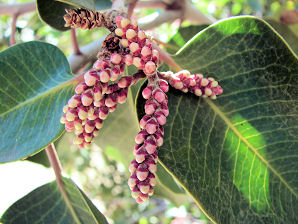Xeriscape Landscaping Plants For The Arizona Desert Environment.
Pictures, Photos, Information, Descriptions,
Images, & Reviews.
Trees.
Sugar Bush, Rhus ovata.
We Are Proud Of Our SafeSurf Rating!
Click On Any Of The Following Links By Amazon.Com
For Books, & Videos About Wildflowers Of Arizona & The Southwest USA. No Obligation!
 |
| Sugar Bush, Rhus ovata. September 13, 2006. Glendale Arizona Xeriscape Demonstration Garden. |
|---|
 | |
| Sugar Bush, Rhus ovata. | Sugar Bush, Rhus ovata. |
|---|---|
 | |
| Sugar Bush, Rhus ovata. | Sugar Bush, Rhus ovata. |
 |  |
| Sugar Bush, Rhus ovata. 2-28-2008. Flower Buds. Getting Ready To Open. | Sugar Bush, Rhus ovata. 3-20-2008. Flower Buds. Beginning To Open. |
 |  |
| Sugar Bush, Rhus ovata. 3-20-2008. Open White Flowers. | Sugar Bush, Rhus ovata. 3-20-2008. Open White Flowers. |
 /
/

Sugar Bush.
We wish to thank Wikipedia, the free encyclopedia for some of the information on this page. We share images and information with Wikipedia. Rhus ovata, also known as Sugar Bush or Sugar Sumac, is an evergreen shrub to small tree that grows in chaparral in dry canyons and south-facing slopes below 4,266 feet in Southern California, Arizona and Baja California. Sugar Bush is normally an eight foot evergreen shrub that can grow to about thirty feet. Most do not reach that height. It has delicate, oval-pointed leaves, requiring a large amount of water. In fact people in Lake Havasu area have had watering difficulty with this plant. Sugar bush likes sun and little or no water after established. The seeds of the Sugar Bush attract seed eating birds and other wildlife to your garden.
Quick Notes:
Height: Up to about 8 - 12 feet tall, spread 6 to 12 feet. Can grow up to about 30 feet.
Bark: Brown to reddish-brown.
Flowers: Large clusters of pink buds turning into cream flowers in late spring - summer. The flowers have red sepals and pinkish to white petals, both with ciliate margins, and occur in fairly dense clusters at the ends of branches.
Blooming Time: March - May. Can also bloom after monsoon rains in late summer.
Fruit: Fuzzy and red in clusters at the ends of the twigs, ripen in late summer and persisting into winter.
Leaves: Leathery, fragrant, ovate, 2 4/5 to 4 inches long. Coriaceous and condulplicate.
Found: The USDA claims it is native of the USA (AZ, CA). In arizona it is native to Mohave, Coconino, Yavapai, Maricope, Gila, & Graham counties. Also native of Mexico in Baja Norte.
Elevation: Native from 850 to 6,000 feet.
Hardiness:
Soil pH requirements:
Sun Exposure:
Habitat: Dry chalky/alkaline slopes in chaparral, scrub, and desert communities. Usually in medium to rocky, coarse textured soils. Typically found inland where it is very dry. An ideal xeriscape landscape plant in Arizona.
Miscellaneous: Photos taken at September 13, 2006. Glendale Xeriscape Demonstration Library.
|



We Are Proud Of Our SafeSurf Rating!
Click On Any Of The Following Links By Amazon.Com
For Books, & Videos About Xerioscape Plants Of Arizona & The Southwest USA. No Obligation!
Back To Arizona Xeriscape Landscaping Main Page.
Back To Xeriscape Shrubs Page Five.
Back To Arizona Wild Flowers Home Page
Back To Arizona Wild Flowers. White Flowers Page Five.
Back To DeLange Home Page
© 1966 - Present, Audrey, Eve, & George DeLange
| © 1966 - Present, Audrey, Eve, & George DeLange |


